<< Previous | Displaying results 6501-6550 of 6768 for "" | Next >>
June 25, 1948. On this date, the US Congress passed the Displaced Persons Act. This allowed approximately 400,000 displaced persons to immigrate to the US.

November 3, 1918. On this day, German sailors in Kiel revolt, and protests against World War I spread.
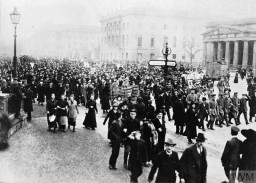
February 23, 1930. On this date, Nazi stormtrooper Horst Wessel dies after being shot and becomes a martyr in Nazi propaganda.
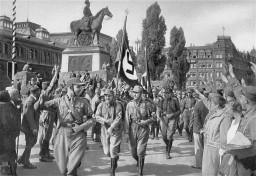
November 12, 1918. On this date, women gain the right to vote in Germany.
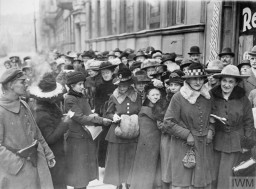
November 11, 1918. On this date, a negotiated ceasefire ends the fighting of World War I when it goes into effect at 11am.

November 18, 1919. On this date, Hindenburg spreads the “stab-in-the-back” myth in a testimony before a committee investigating Germany’s defeat in World War I.
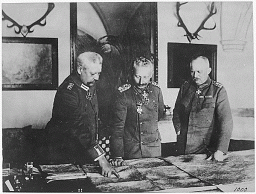
May 12, 1925. On this date, German Field Marshal Paul von Hindenburg is inaugurated, becoming the last president of the Weimar Republic.
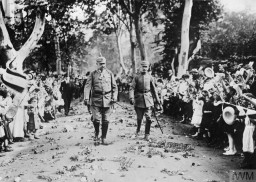
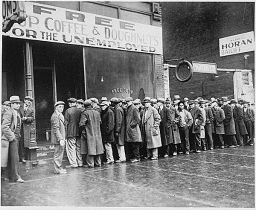
November 22, 1930. On this date, Nazis attack a leftwing group at a dance hall in Berlin.
December 1935. The Lebensborn program is created at the direction of Heinrich Himmler in order to combat Germany’s falling birth rate.

June 1936. German physician Robert Ritter becomes head of a new eugenics research center focusing on racially classifying Roma and Sinti.

June 6, 1936. On this date, Minister of the Interior for the Reich and Prussia Wilhelm Frick issues a decree on “Combating the Gypsy Plague.”
July 16, 1936. On this date, German authorities order the roundup of Roma and Sinti in Berlin, confining them in a new camp in the Marzahn suburb.

December 08, 1938. On this date, Himmler orders that Nazi Germany’s policies regarding Roma and Sinti should be developed according to Nazi racial principles.
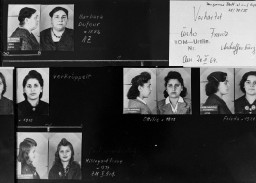
December 16, 1942. On this date, Heinrich Himmler issues an order that Roma and Sinti are to be deported to Auschwitz.
April 26, 1933. On this date, the British ambassador to Germany warned the British government about the principles outlined in Hitler’s Mein Kampf.
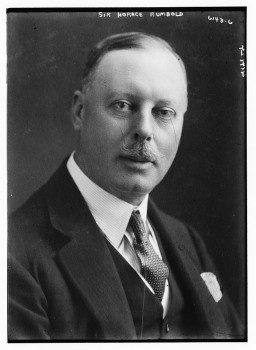
June 18, 1935. On this date, the United Kingdom and Germany signed an agreement allowing the German navy to expand beyond the terms of the Treaty of Versailles.
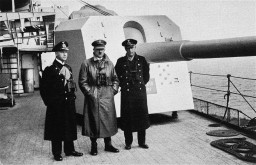
May 28, 1937. On this date, Neville Chamberlain succeeded Stanley Baldwin as British prime minister.
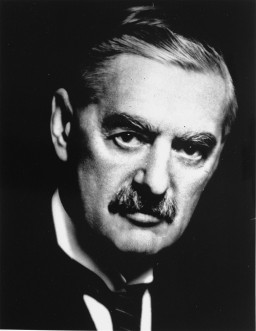
May 1937. Neville Chamberlain became British prime minister and followed a policy of appeasement towards Nazi Germany.
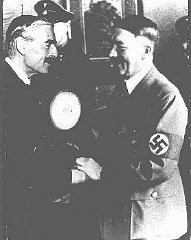
March 14, 1938. Days after Nazi Germany annexed Austria, Churchill delivered a warning about German aggression.
September 15, 1938. On this date, British Prime Minister Neville Chamberlain met with Hitler at the German leader’s home in Berchtesgaden.

Adolf Hitler authorized the murder of people with disabilities sometime in autumn 1939 but backdated the order to the start of World War II.
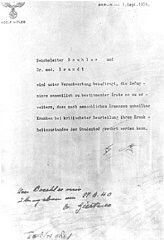
March 5, 1946. On this date, Winston Churchill delivered his postwar “Iron Curtain” speech.
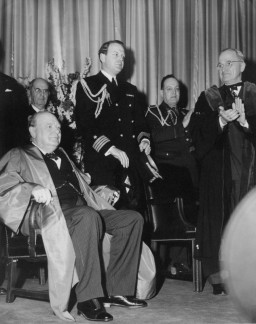
March 11, 1941. On this date, the Lend-Lease Act passed in Congress, allowing the United States to send material aid to the Allies prior to entering World War II.

September 17, 1945. On this date, the Belsen Trial began. Forty-five defendants were charged for crimes committed at the Bergen-Belsen concentration camp.
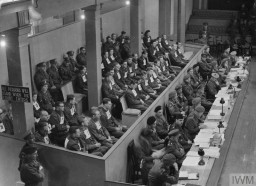
October 5, 1938. On this date, Winston Churchill delivered a speech denouncing the Munich Agreement.
September 7, 1940. On this date, Germany initiated the Blitz, a bombing campaign against Britain.

September 30, 1938. On this date, Neville Chamberlain addressed the public after signing the Munich Agreement, proclaiming "I believe it is peace for our time."
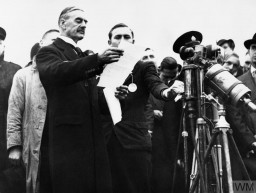
August 18, 1939. On this date, German officials ordered the registration of infants and toddlers showing signs of mental or physical disabilities.
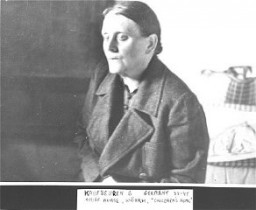
May 10, 1940. On this date, Winston Churchill succeeded Neville Chamberlain as British prime minister.
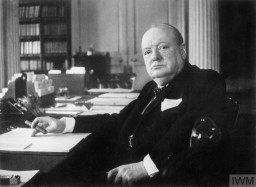
May 1940. Approximately 338,000 Allied troops evacuate Dunkirk with the help of British ships and boats.

July 10, 1940. On this date, Germany and Britain began fighting for air control of the English Channel in the Battle of Britain.

August 14, 1941. On this date, President Roosevelt and Prime Minister Churchill issued the Atlantic Charter establishing postwar priorities.

October 30, 1943. On this date, the United States, Great Britain, and the Soviet Union signed the Moscow Declaration during the Third Moscow Conference.

Listen to excerpts from oral testimonies to learn from survivors themselves about their individuals experiences, actions, and choices.
Explore a timeline of events that occurred before, during, and after the Holocaust.
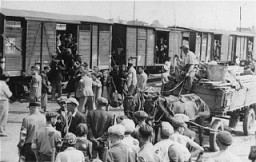
Hitler's political opponents were the first victims of systematic Nazi persecution. They were incarcerated without trial and under conditions of great cruelty.
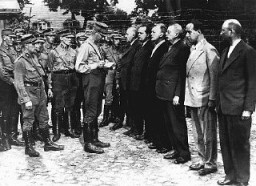
Learn about the origins and legacy of Pastor Martin Niemöller's famous postwar words, “First they came for the socialists, and I did not speak out…”
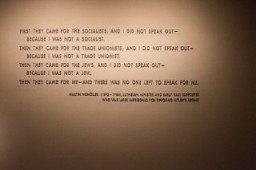
Hitler rose to power during a time of economic and political instability in Germany. Learn more about how and when Hitler came to power.
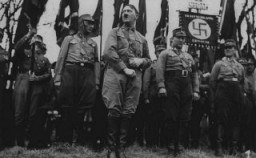
Is the “Final Solution” the same as the Holocaust? Did the Nazis always plan to murder the Jews? Learn the answer to these and other questions about the Nazi “Final Solution.”
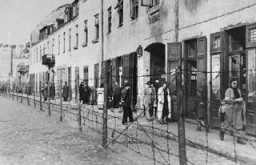
The SS established the Sachsenhausen concentration camp as the principal concentration camp for the Berlin area. Located near Oranienburg, north of Berlin, the Sachsenhausen camp opened on July 12, 1936.
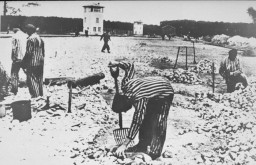
A group of young German boys view Der Stuermer, Die Woche, and other propaganda posters that are posted on a fence in Berlin, Germany, 1937.
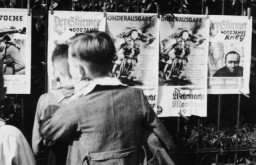
American residents of Japanese ancestry wait with their luggage for transportation during relocation, San Francisco, California, April 6, 1942.
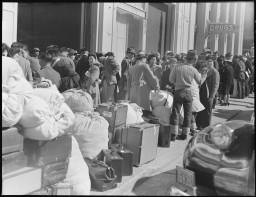
Tatsuro Matsuda, whose family owned the Wanto Co. grocery store, hung this sign in front of the store, Oakland, California, March 1942. The store was closed following orders for the evacuation of Americans of Japanese ancestry. Evacuees were forcibly deported to relocation centers.

Japanese Americans wait in line to register with the War Relocation Authority, San Francisco, California, April 1942. A government agency, the War Relocation Authority was tasked with removing “enemy aliens” from designated zones. Local authorities on the West Coast forced all “persons of Japanese ancestry” to register. They were then deported, first to temporary “assembly centers” and from there to relocation centers.
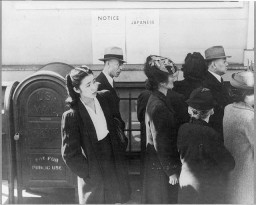
Hilda Rattner (born Hilda Wiener ) was born into a Jewish family in Vienna on June 14, 1904. Not long after her birth, Hilda’s parents realized that she was deaf. Two years later, their fourth child, Richard, was born, and he was also deaf. Vienna in particular had a very vibrant deaf community where Jews and non-Jews mixed freely. Hilda and her brother Richard attended a Jewish school, where they learned to sign, and it was through these associations and activities that Hilda met Isadore Rattner, a…

Portrait of Helen Keller, seated, reading Braille. September 1907. In 1933, Nazi students at more than 30 German universities pillaged libraries in search of books they considered to be "un-German." Among the literary and political writings they threw into the flames during the book burning were the works of Helen Keller.
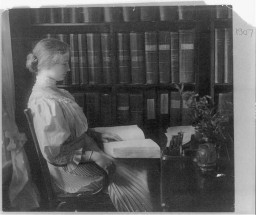
The most notorious of the 189 known interrogation centers in Cambodia was S-21, housed in a former school and now called Tuol Sleng for the hill on which it stands. Between 14,000 and 17,000 prisoners were detained there, often in primitive brick cells built in former classrooms. Only 12 prisoners are believed to have survived.

Secretary of Labor Frances Perkins testifies before the House Committee on migrant workers. Washington D.C., December 1940.

Lois Gunden (center right) with other members of the Ville St. Christophe staff in Canet-Plage, France. At the age of 26, Lois Gunden, a Mennonite and French teacher from Goshen, Indiana, sailed to Europe to head the Ville St. Christophe refugee children’s home in Canet-Plage, France. She had not been involved with overseas relief work before, and had never been to Europe. But she spoke French, and the Mennonite Central Committee needed someone willing to place herself in danger to help others.…
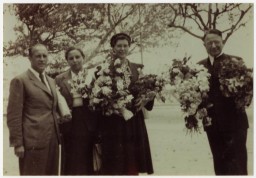
We would like to thank Crown Family Philanthropies, Abe and Ida Cooper Foundation, the Claims Conference, EVZ, and BMF for supporting the ongoing work to create content and resources for the Holocaust Encyclopedia. View the list of donor acknowledgement.